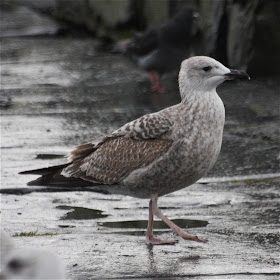Well if that isn't a great headline I don't know what is...
Thought that since the blog had already strayed into a few areas of impossibly speculative identifications this week (e.g. Nordic Jackdaw and Mealy Redpoll only yesterday) then I may as well post these pictures of second winter Herring Gulls photographed at Nimmo's Pier, Galway, on 28 December. My aging and subspecific identification of these Herring Gulls is tentative, as there is a bewildering array of plumage types and patterns out there...
This first bird is possibly of the northern argentatus subspecies as it was a bulkier bird in direct comparison to other similarly aged birds (though maybe it is just a large male?) and it has heavily marked scapular feathers. Its wing coverts were unusually uniform in colour and a little more bleached compared to most others. How common is that?
Hmm... I am now beginning to wonder whether I have aged this bird correctly. I aged it as a second winter based on the heavily worn rounded tips to the primaries. However, looking at almost all other features of the plumage, it appears to be a first winter and now that I have considered it as a first winter - it seems perfect, and the primary tips on closer inspection are slightly pointed. So, scratch the comment above, this is not an unusual second winter with retained juvenile coverts, it is a first winter that appears to have more abraded primaries than normal. Ok... let's move on...
The next bird was only seen in flight but had a grey background colour, a finely barred rump and fairly uniform wings. I think that it has been suggested that birds with this plumage could be reasonably common among the Icelandic argenteus population, but that they are not restricted to that area. It is also possible that some argentatus may look like this. Any ideas?
I enjoyed photographing the next bird, which caught my eye as it had a slightly more advanced moult of its silvery mantle feathering and a whiter head. I think that it may be from a less northerly population to have progressed its moult - although of course there is much individual variation - but I'm going to guess its a local argenteus bird. It also showed a darker and more finely vermiculated greater covert bar than most of the other birds in the group and a strongly dark leading edge of the wing - both characters are shared with the bird above.
Enough for now... If you know more about large white-headed gulls than me, which is quite likely, then please do drop me a line and maybe I could add some more informative captions!









No comments:
Post a Comment